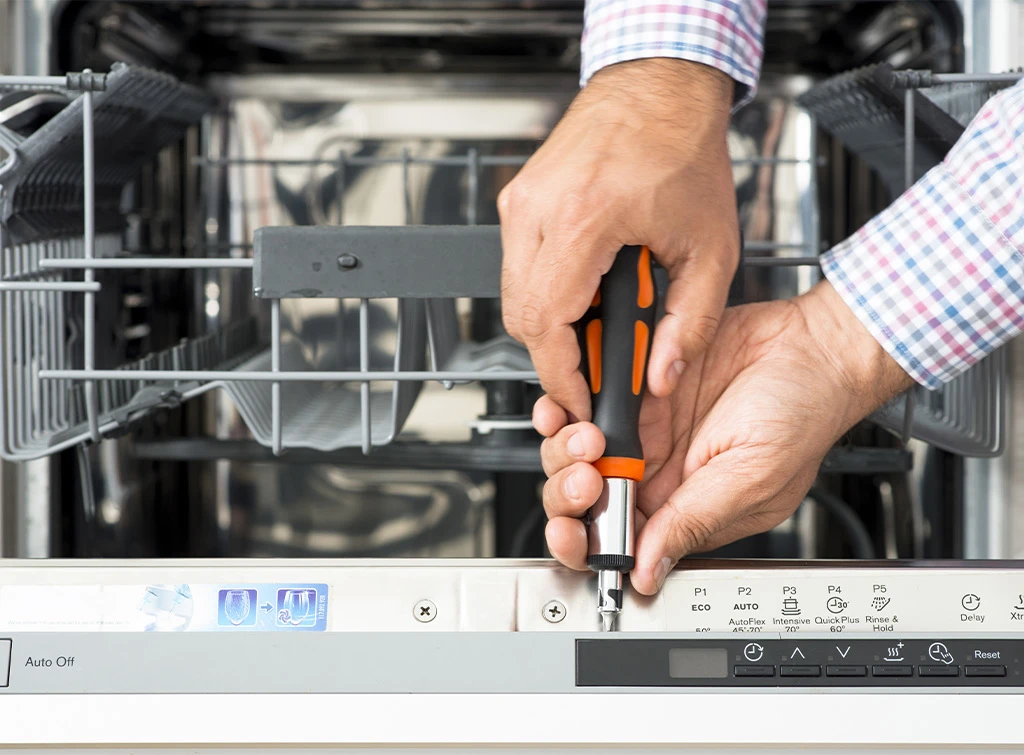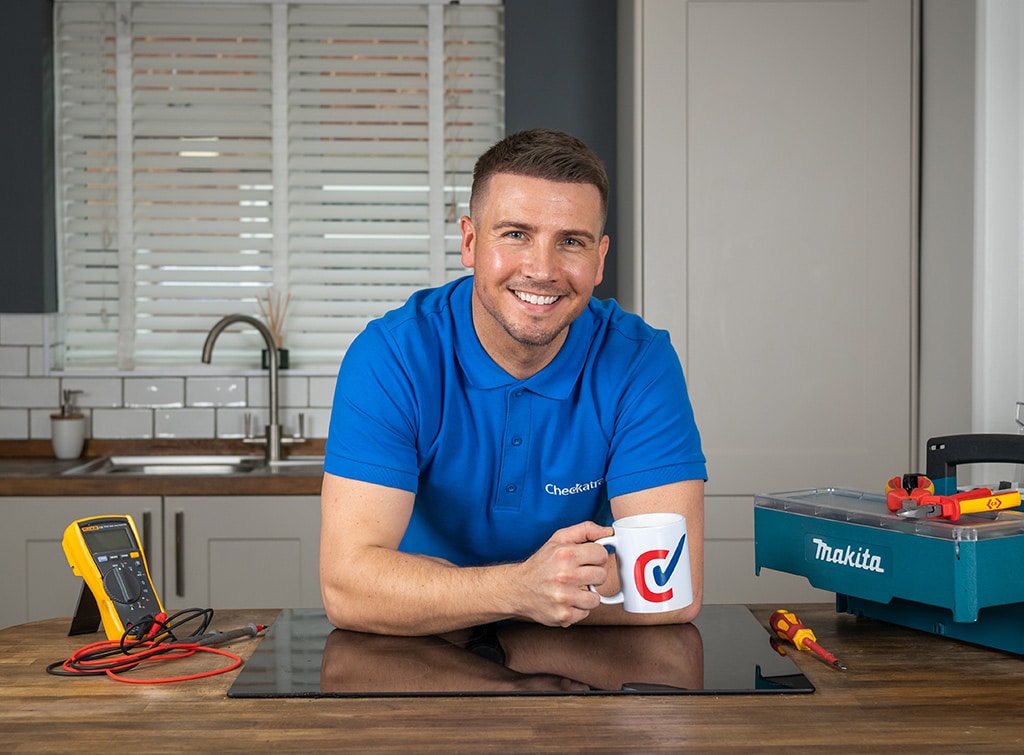Blog>Expert Advice>Dishwasher not draining - what to do
Last updated: 23 September 2024
Dishwasher not draining - what to do
An inch or more of standing water in your dishwasher suggests it's not draining. It might have a blockage or other problem causing a puddle. Read on to find out why this happens and how you can fix it.

Why is there water in bottom of dishwashers?
When you've got an inch or more of dishwasher water not draining, the cause is usually a blockage.
But, there can be more than one cause of standing water in dishwashers.
Finding the problem is the easiest way to get your dishwasher back in working order.
Reasons for a clogged dishwasher drain
If you have a clogged dishwasher drain, the causes can include:
Rubbish disposal blockages
A faulty drain valve or drain pump
Food, oil and minerals clogging the dishwasher filter
A kinked or clogged drain hose restricting water flow
Clogged air gaps (the small fitting on top of the sink)
A broken, stuck or clogged float switch that can't regulate water levels
Incorrect dishwasher installation of the drain hose or other connections
Excessive detergent or washing-up liquid creates suds that stops water from escaping
Before you poke around, check your children haven't put washing-up liquid in there!

How to fix a dishwasher not draining
You can try to unclog or fix your dishwasher using one of the methods below.
1. Unclog the dishwasher filter
A clogged filter is one of the most common culprits of a dishwasher not draining.
Here's how to check for a clogged filter:
Locate the dishwasher filter under the bottom rack
Remove it and clean off any food or debris blocking the water flow
Then, look around the drain for other blockages
You might notice large pieces of discarded food or even broken glass
Rinse the area - try a mix of vinegar and warm water to sanitise
Or, use a hot rinse cycle to dislodge minor clogs
You can also try a dishwasher-safe cleaner
Speciality cleaning products can help break down grease and grime, which can then go on to clog your dishwasher's internal components.
The ultimate guide to appliance maintenance
Our ultimate guide to appliance maintenance will help to make sure your appliances operate safely and efficiently while prolonging their lifespan.
2. Unclog the dishwasher drain hose
If cleaning the filter doesn't help, you may have a problematic clog in the drain hose.
To unclog the dishwasher drain hose, you'll need a:
Cup
Bucket
Towel
Cleaning solution
Soft brush/old toothbrush or plumber's snake
Here's what you'll need to do:
Avoid safety hazards by emptying the dishwasher and switching it off at the fuse
Remove any standing water in the dishwasher to see what's blocking the dishwasher drain
Use a cup or jug and soak the rest up with towels - a wet/dry vac can also be helpful here
Remove the kickplate underneath the dishwasher to access the hose connected to the sink drain or rubbish disposal
Detach the hose and inspect it for clogs
Clear blockages with a long, soft, flexible brush or a small plumber's snake
Clean the drain hose with a store-bought or DIY drain cleaner solution
Put everything back together - once you've cleared the hose, reattach it to test it
Switch the power back on and run a rinse cycle to see if your dishwasher drains.
Not comfortable poking around your appliances?
A good dishwasher repair service can offer a quick solution.
See the tradespeople we've checked and recommend for your job
3. Check the drain pump
It's also worth checking your dishwasher for glass breakages.
These breakages can happen during a wash cycle and quickly reach the drain pump outlet.
Even tiny shards can lessen your pump's effectiveness and cause standing water.
To resolve this, remove the drain pump and clear out any debris.
Follow these steps:
Turn off the dishwasher by unplugging it or switching it off at the fuse box
Remove the dishwasher's bottom panel or kickplate to reach the drain pump - you might need to use a screwdriver to unscrew the panel
Carefully disconnect the drain pump from the dishwasher by unscrewing the pump or releasing the clips
Remove any debris from the drain pump and outlet - a torch, pliers, tweezers, or small hook tool can be helpful
Before reassembling, test the pump impeller (the spinning part of the pump) to check it moves freely
You may need to replace the impeller if it doesn't move or is damaged
Reassemble your pump and attach the drain pump securely, making sure all connections are snug
To check your pump is working correctly, you can use a multimeter to measure the resistance of the impeller.

4. Clean the sink's air gap
Your dishwasher's air gap is located on top of the sink. It lets air into the dishwasher to drain properly without creating a vacuum.
Your dishwasher's air gap can become blocked or clogged, causing drainage problems.
Have you noticed dirt, debris, or buildup in the sink's air gap? Cleaning it out might get your dishwasher draining again.
Other ways to unclog your dishwasher
If none of the methods above unclog your dishwasher, you can also try:
Looking for clogs in your sink plumbing
Clearing the rubbish disposal of any blockages
Checking if the dishwasher motor is running properly
Resetting the dishwasher if it's displaying any error codes
Examining the float switch to check it's regulating the water levels
Checking the door latch - it can stop the drain cycle when it doesn't close properly
Getting help
If you've tried all these methods and still have a dishwasher not draining, you might want to call a professional.
At Checkatrade, we can help.
You'll only find trades who meet our high standards and pass our checks on Checkatrade. We're so confident in the quality of the trades on Checkatrade that if you book through us, we guarantee their work up to £1,000. Guaranteed for 12 months – Eligibility and T&Cs apply.
Add your postcode to get started.
See the tradespeople we've checked and recommend for your job
More Expert Advice Articles
More Dishwasher Repair Articles
See the tradespeople we've checked and recommend for your job






